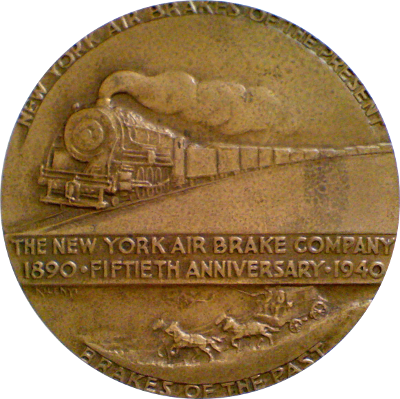

The obverse bears scene of steam train speeding around a bend in upper half. Two line inscription on a raised band across: THE NEW YORK AIR BRAKE COMPANY/ 1890 FIFTIETH ANNIVERSARY 1940. Underneath, a carriage drawn by 4 horses. Around top, NEW YORK AIR BREAKS OF THE PRESENT; below BRAKES OF THE PAST.
The reverse depicts an actual air brake. Above, under laurels, GOLDEN JUBILEE; below, AIR BRAKES BRING / SURETY AND SWIFTNESS
The medal is edge-marked ROBBINS CO / ATTLEBORO - GENUINE / BRONZE.
The New York Air Brake Company has a fascinating history including intrigue, corporate raiding, and even murder. In the late 19th century the booming railroad industry was in desperate need of a good braking system. As trains had gotten faster, slowing them down in a controlled fashion became an ever more pressing problem. By the 1860s, two systems were competing for dominance: a vacuum system and a pressurized air system.
Frederick Eames was an inventor who moved to Watertown, NY, in 1874 where he founded the Eames Vacuum Brake Company in 1876. After his top sales man had attempted to cheat him out of the company, he went to court and won back control in 1882. Unfortunately, he was fatally shot while retaking the factory in 1883.
The company was re-incorporated by John Thompson in 1890 as the New York Air Brake Company. Wall Street raiders used manufactured bad news to profiteer in the stock markets. Two investors stayed faithful and protected the young company. While Westinghouse had pioneered air brakes and consequently had a lead in the marketplace, the industry was reluctant to accept one monopoly supplier. Consequently, New York Air Brakes prospered with the growing railroad industry. Finally, in 1912, Westinghouse and New York Air Brakes agreed to share the market and started cooperating on research and development.
While the somewhat pedestrian motif of an air brake on the medal's reverse does not seem all too poetic, the fascinating story more than makes up for any perceived shortcomings. It is a beautiful example of an industrial medal of the 1940s.
The medal measures 76mm (3in) and was struck by the Robbins Company of Attleboro, Massachusetts in bronze.